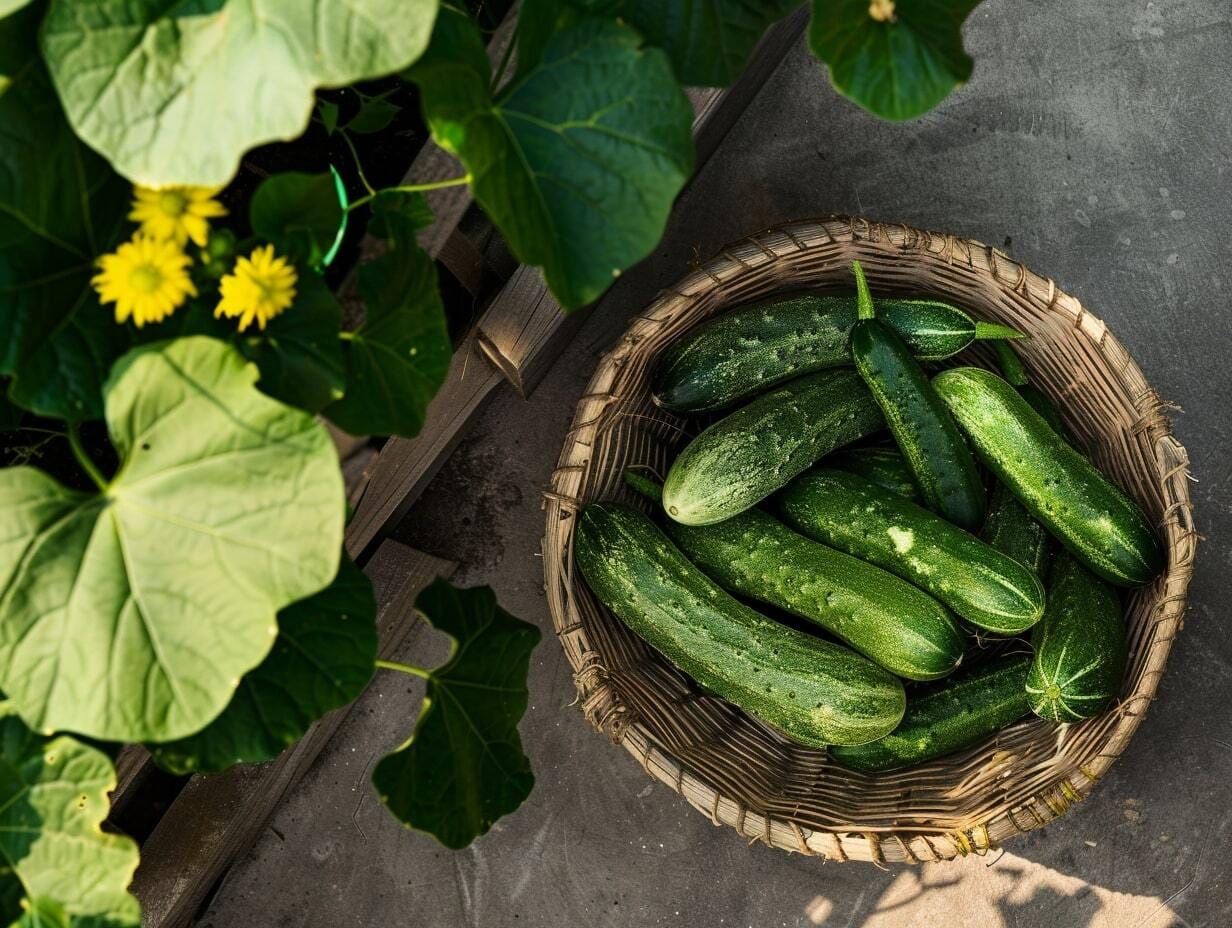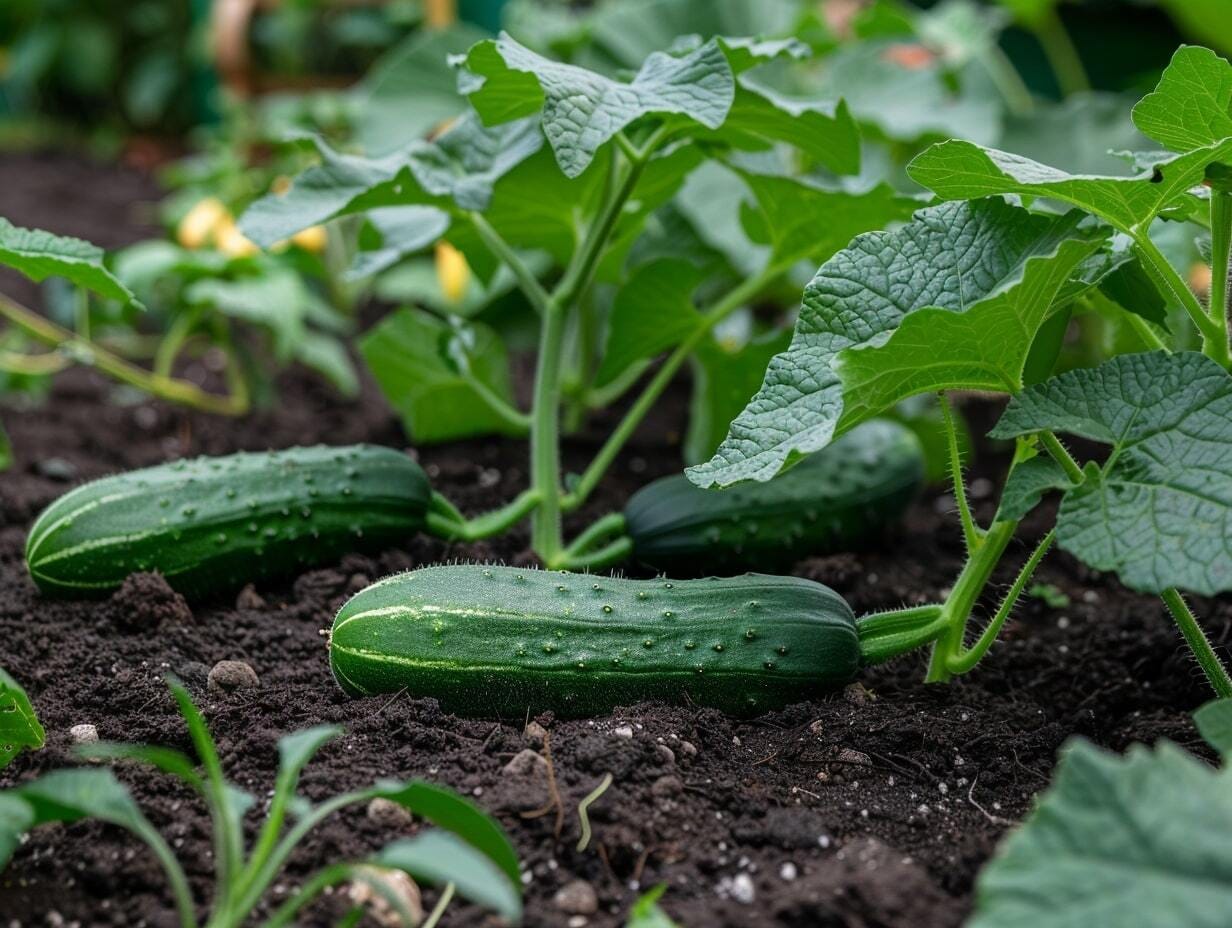When you buy products via links on our website, we might receive an affiliate commission. Learn more
Get 300% More Cucumbers from Your Garden – Here’s How!

Gardening is a rewarding activity, but nothing beats the joy of a bountiful harvest. If you're looking to significantly boost your cucumber yield, you’re in the right place. With some strategic planning and a bit of know-how, you can increase your cucumber harvest by 300%.
Here’s a comprehensive guide on how to make your cucumber plants thrive and produce more than ever.
Choose the Right Variety

The journey to a high-yield cucumber garden starts with selecting the right cucumber variety. Some cucumber varieties are naturally more prolific than others.
Look for high-yielding, disease-resistant varieties such as:
- Marketmore 76: Known for its disease resistance and high yield, Marketmore 76 produces dark green cucumbers with a uniform shape and excellent taste. This variety is great for fresh eating and pickling.
- Sweet Success: A prolific producer with a sweet taste, Sweet Success cucumbers are nearly seedless and can grow up to 12 inches long. They are also resistant to common cucumber diseases like powdery mildew and cucumber mosaic virus.
- Armenian Cucumbers: Technically a melon but tastes like a cucumber, Armenian cucumbers (also known as yard-long cucumbers) thrive in hot climates and can produce fruit up to 3 feet long. Their thin skin doesn’t require peeling, and they are crisp and flavorful.
In addition to these varieties, consider experimenting with hybrid varieties that have been bred specifically for high yield and disease resistance. Consult with local gardeners or your extension service for additional insights into the best varieties for your area.
Prepare the Soil for Maximum Yield

Healthy soil is the foundation of a productive garden. Cucumbers prefer well-drained, fertile soil with a pH of 6.0 to 7.0. Here’s how to prepare your soil for maximum yield:
- Test Your Soil: Use a soil testing kit to check the pH and nutrient levels. Most garden centers offer these kits, and some even offer soil testing services.
- Add Organic Matter: Incorporate compost or well-rotted manure to improve soil fertility. Organic matter enriches the soil with essential nutrients and improves its texture, making it easier for cucumber roots to grow.
- Ensure Good Drainage: If your soil is heavy clay, consider raised beds or add sand and compost to improve drainage. Cucumber roots do not like to sit in waterlogged soil, which can lead to root rot and other issues.
- Adjust pH Levels: If your soil pH is too low (acidic), add lime to raise it. If it’s too high (alkaline), add sulfur or peat moss to lower it. Maintaining the right pH level helps your cucumber plants absorb nutrients more efficiently.
Practice Optimal Planting
Timing and spacing are crucial for a successful cucumber harvest. Follow these guidelines for planting:
- Consider the Planting Time: Cucumbers are warm-season crops. Plant them after the last frost date when the soil temperature is consistently above 60°F (15°C). In cooler climates, start seeds indoors 4-6 weeks before the last frost date and transplant them outdoors when the weather warms up.
- Pay Attention to Spacing: Plant cucumber seeds or seedlings 12-18 inches apart in rows that are 3 feet apart. This spacing allows for proper air circulation and reduces the risk of disease. If using a trellis, you can space plants closer together, around 6-8 inches apart, to maximize vertical growing space.

- Determine the Right Seed Depth: Plant cucumber seeds about 1 inch deep. If transplanting seedlings, ensure the root ball is covered and the plant is at the same depth as it was in the pot.
Follow Effective Watering Tips

Cucumbers need consistent moisture to produce well. Here are some tips for effective watering:
- Water Deeply: Water the plants deeply at least once a week, ensuring the soil is moist but not waterlogged. In hot weather, you may need to water more frequently. Deep watering encourages deep root growth, making plants more drought-resistant.
- Follow the Right Mulching Techniques: Apply a layer of mulch around the plants to retain moisture and suppress weeds. Organic mulches like straw, wood chips, or grass clippings also add nutrients to the soil as they decompose.
- Avoid Wetting Foliage: Water at the base of the plants to prevent fungal diseases that can occur with wet foliage. Drip irrigation systems or soaker hoses are excellent for this purpose, delivering water directly to the roots.
- Focus on Morning Watering: Water your cucumbers in the morning to reduce evaporation and allow the plants to dry out during the day, further preventing disease.
Create a Comprehensive Fertilization Plan
Cucumbers are heavy feeders and benefit from regular fertilization. Here’s a fertilization plan to boost your yields:
- Use a Balanced Fertilizer During the Pre-Planting Phase: Incorporate a balanced fertilizer into the soil before planting. A 10-10-10 (N-P-K) fertilizer works well for cucumbers. Spread it evenly and work it into the top 6 inches of soil.
- Leverage Nitrogen Fertilizers During Growth: Apply a nitrogen-rich fertilizer when the plants start to vine. Nitrogen promotes vigorous growth and healthy foliage. Fish emulsion or blood meal are excellent organic options.
- Move to Potassium Fertilizers When Flowering: Switch to a potassium-rich fertilizer when flowers appear to promote fruiting. Potassium supports flower and fruit development. Consider using a 5-10-10 fertilizer or adding composted banana peels or wood ash to your soil.
- Avoid Over-Fertilization: Too much fertilizer, especially nitrogen, can lead to excessive foliage growth at the expense of fruit production. Follow recommended application rates and avoid applying too close to the plant stems.
Use Trellises to Support Cucumber Plants
Supporting your cucumber plants can significantly increase your yield by promoting better air circulation and easier harvesting. Here’s how:
- Use Trellises: Install trellises or cages for your cucumber plants to climb. This keeps the fruits off the ground, reducing the risk of rot and pest damage. Trellising also saves space, allowing you to grow more plants in a smaller area.
- Explore Different Types of Trellises: A-frame, vertical netting, or cattle panels are popular trellising options. Ensure your trellis is sturdy enough to support the weight of mature plants and fruit.
- Train the Vines: Gently guide the vines to grow up the trellis. Secure them with garden ties if necessary. Regularly check the vines and adjust them to ensure they are evenly distributed on the trellis.
- Pay Attention to Pruning: Prune the lateral shoots (side branches) to direct the plant’s energy towards the main vine and fruit production. This also improves air circulation and light penetration.
Keep the Cucumber Plants Pest-Free
Keeping your cucumber plants healthy and pest-free is vital for a high yield. Here are some strategies:
- Practice Regular Inspection: Check your plants regularly for signs of pests such as aphids, cucumber beetles, and spider mites. Look for discolored leaves, holes, and other damage.
- Draw Natural Predators: Encourage beneficial insects like ladybugs and lacewings that prey on cucumber pests. Planting flowers like dill, fennel, and marigolds can attract these helpful insects.
- Use Organic Sprays: Use neem oil, insecticidal soap, or homemade garlic and chili spray to control pests. Apply these treatments early in the morning or late in the evening to avoid harming beneficial insects.
- Practice Crop Rotation for Disease Prevention: Rotate crops annually to prevent soil-borne diseases. Avoid planting cucumbers in the same spot where other cucurbits (squash, melons) were grown the previous year. Remove and dispose of infected plants immediately to prevent the spread of disease.
- Make the Most of Companion Planting: Grow cucumbers with companion plants that repel pests and enhance growth. Nasturtiums, radishes, and marigolds are excellent choices for deterring pests.
Harvest Like a Pro
Proper harvesting techniques can prolong your cucumber plants' productivity.

Follow these tips:
- Focus on Regular Harvesting: Pick cucumbers regularly, every couple of days, to encourage the plants to produce more. Leaving overripe cucumbers on the vine signals the plant to slow down production.
- Pick the Correct Size: Harvest cucumbers when they reach the desired size. Overripe cucumbers can become bitter and reduce the plant’s productivity. Pick slicing cucumbers when they are 6-8 inches long and pickling cucumbers at 3-4 inches.
- Handle the Harvest Carefully: Use a sharp knife or pruners to cut the cucumbers from the vine to avoid damaging the plant. Handle cucumbers gently to prevent bruising, which can lead to spoilage.
- Store the Harvest in Cool Environments: Store harvested cucumbers in a cool, humid environment to maintain freshness. They can be refrigerated for up to a week.
